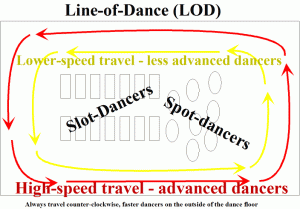FAQs
DanceWell welcomes you to the exciting, fun and rewarding hobby of ballroom dancing. To start you off on your dancing journey here are some insights and answers to the most common questions asked by new students.
Frequently Asked Questions About Ballroom And Social Dance Classes
DanceWell welcomes you to the exciting, fun and rewarding hobby of ballroom dancing. To start you off on your dancing journey here are some insights and answers to the most common questions asked by new students.
Dance is a different world where the highest math is “1-2-3” and where it’s okay not to know everything since that’s where we all begin. Dancing classes are different from college credit classes, where passing is by knowing the information. Muscle memory takes longer to incorporate than brain memory. Apply the Rule of 1,000 for best results and plan to continue through our Beginners program. Better to take classes until the steps are so smooth people think you’ve been dancing for years. When watching better dancers you’ll note that they don’t use many moves; they just look great at the ones they use. The true challenge is in your own determination and commitment. Even small improvements in memory, knowledge, endurance, timing, muscle and musical coordination, teamwork and communications skills will soon begin to increase your confidence and your eagerness to learn. There are 4 stages to the learning process:
- Unconsciously Incompetent (a blissful state);
- Consciously Incompetent (very uncomfortable);
- Consciously Competent (Progress!); and
- Unconsciously Competent (WooHoo! Definitely worth the work!)
The answer? Both! Ideally, a combination of private and group instruction is the best choice. Group instruction primarily focuses on dancing patterns and involves many students under the direction of one instructor. Classes are taught to the general level of the people in the class and are great for learning patterns and being told about technique and styling. A series is (4) weeks, teaching patterns of a certain “level”. No partner is necessary as we rotate partners frequently during class. Private instruction is one-to-one learning, whether as a single or a couple, and is tailored to suit the learning needs of each student. This allows you the freedom to advance at your own pace, learning techniques too subtle to learn in group classes. These are the lessons that will help develop all the necessary skills to make you an excellent dancer. Private lessons can cover one or several dances during the lesson and can be either 1/2 or 1/hour long.
Clean, comfortable clothing can be either dressy or casual, and deodorant and breath mints are provided for our guests use. It is recommended that you wear clothing that will give you freedom of movement. Loose slacks or a skirt for women. Sport or polo shirts and loose slacks for men. Shoes with a thin, flexible sole are best for men. Women can wear a heel, since that is the normal shoe of choice when dressing up, but if practicing a lot best to wear flats. Special footwear designed for dancing in a variety of styles is available to you through dance stores or the internet including dance sneakers. Walking shoes with thick soles or rubber soles, sneakers or athletic shoes are not recommended. Although comfortable, they are not flexible enough for dancing, and may even cause injury.
If you have a partner that’s great! But no partner is needed at any DanceWell Ballroom party, class, or private lesson. During the class, the instructor will have you rotate partners every few minutes so you will have the opportunity to dance with everyone in the class. In our comfortable atmosphere dancing with a variety of people is the best way to learn social dancing and is also a great way to meet people.
Rotating partners is a common and excellent teaching technique, and an important part of learning to dance.
It’s easiest to start with what you already like – what type of music do you listen to most? Some dances are easier to learn than others. NOTE: This does NOT mean you should not learn the dance you want — just that it may be a little more difficult until you have developed movement and partnering skills. See our Dance Recommendations for help.
For more information about skill levels and the appropriate path to growth, review our Curriculum Overview which goes into more depth about class skills and levels.
Practicing a little every day would be ideal since you are learning new skills, but as we know life happens so do your best. The ‘Rule of 1,000 reps’ for each pattern learned is a good one. Intensive practicing with or without a partner is best scheduled at the studio and if you’re taking classes or lessons it’s free.The DanceWell Ballroom Program also has weekly Dances every Thursday so students can practice their dancing; we also have monthly Socials. The parties give you the chance to dance in a “nightclub” atmosphere that will help you recognize one dance from another, dance with multiple partners, and learn to maneuver on a crowded dance floor. You needn’t wait until you think you are good enough to attend a party. Though sometimes confusing at first, going to these sessions will help you eventually build your confidence and become better, faster. I’m sure Yoda meant to say!” The might oak was once a little nut who held it’s ground. Continuity and perseverance are keys to success”
Dance Floor Etiquette

Travel counter-clockwise around the room with advanced dancers toward the outer edge of the room; less advanced dancers closer to the center of the room.
One of the most common customs since the 1500’s is the traditional direction of movement around a dance floor. The floor is visualized as center space and outside circles, like a race track. “Moving” or “traveling” dances such as Waltz, Foxtrot and Tango rotate anti-clockwise around the ballroom on the outside circles. The faster-moving the dance couple the farther to the outside.
Social Customs
- At Social Dance Parties there usually is a small “mixer” dance lesson where people meet and greet potential dance partners for the evening.
- Both men and women commonly ask each other for dances.
- During the evening a “2-dance custom” (of dancing up to 2 dances with one person before changing partners) is the general way.
- Many times there are one or two “mixer” dances, where partners are quickly changed throughout one dance song (this is usually a Waltz, Swing or Foxtrot mixer).
Special Note: Though it’s much more fun to dance with men (leaders) and women (followers) who have made the effort to learn good partnering and movement skills, “unasked-for” advice is not appropriate in a social venue.
The choice is yours to either: repeat the same class to strengthen your skills or finesse; continue to the next level of classes if you know longer have to “think” about the steps; or register for other Beginner or Beyond Beginner classes to learn another dance. Most students continue taking Beginning level classes for 6-9 months to build a strong foundation for their dancing as well as decide which dances they would like to focus on.
Points to consider before moving to a new class level:
- Have I evaluated where I may need improvement?
- Am I consistently with the rhythm of the music?
- Am I clearly leading/following my partners?
If not, any class will help improve your general partnering skills and understanding. Is there another DanceWell class in the same general style (of Smooth, Latin or Swing) available? Will a couple of private lessons prepare me for the next level?
The basic difference between the two types of dancing is different patterns, although American “Smooth” Ballroom can be danced both in open and closed position, while International “Standard” is in closed dance frame only. They are still the same Waltz, Foxtrot and Tango. International Style is based on more strict body contact and formalized patterns and foot positions. In Latin (International) and Rhythm (American), the patterns are different but the general dances are the same except for some small variations in technique. In the Portland Area both International and American styles are considered “Social” dancing.

Quick Links
Contact Details
Need help? EMAIL or call Linda 503.241.0460.
DANCEWELL PDX SCHOOLS
BEAVERTON (near Aloha) 3425 SW 185th Ave., 97006
NE PORTLAND (Parkrose) 4848 NE 105th Ave.,97220
Click HERE for maps and directions.

